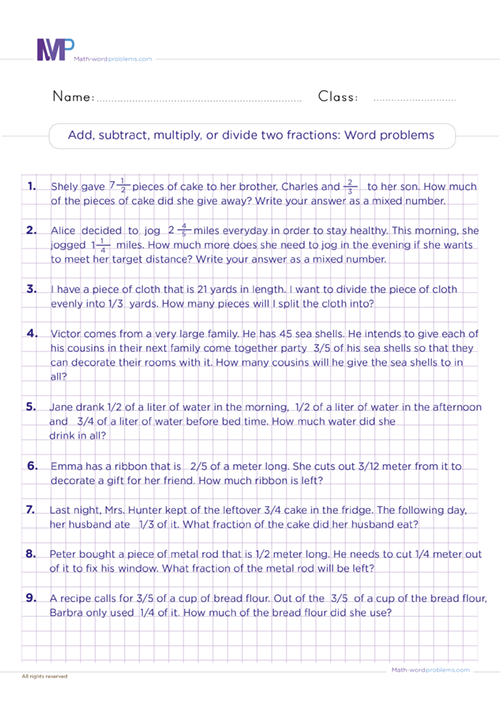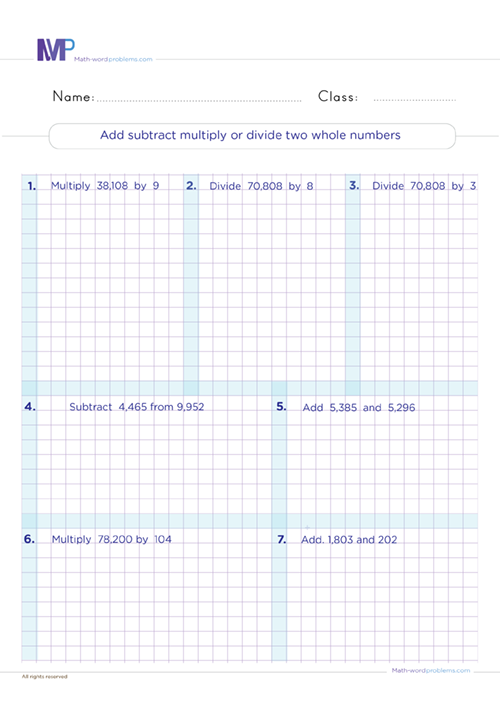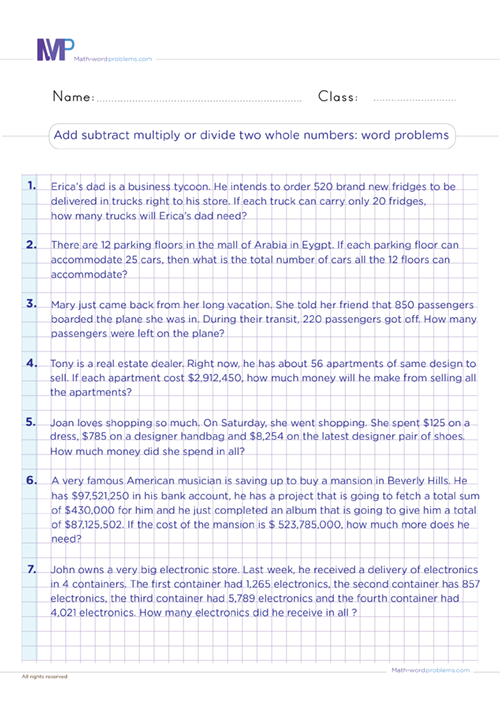 How to solve addition, subtraction, multiplication and division of fractions word problems
How to solve addition, subtraction, multiplication and division of fractions word problems

- INTRODUCTION
- Step 1 IDENTIFY
- Step 2 STRATEGIZE
- Step 3 SET UP
- Step 4 PROVIDE A SOLUTION
- Step 5 CHECK YOUR WORK
Get more contents on this skill...
As a parent, guardian, teacher, tutor, or learner, you must have probably pondered how to solve addition, subtraction, multiplication, and division of fractions word problems. Think no more because our outstanding step-by-step guide is here to help. In fact, this step-by-step guide will promote self-learning and reasoning complexity of your kids on word problem solving concerning addition, subtraction, multiplication, and division of fractions.
Furthermore, this guide outlines a promising method for teaching sixth graders to represent and solve math word problems efficiently. Thus the best way to enhance your kid's problem-solving performance.
Steps to Solve Addition, Subtraction, Multiplication, and Division of Fractions Word Problems
Beneath, you'll find some thrilling steps to solve addition, subtraction, multiplication, and division of fractions word problems. These steps focus on better supporting kids to maximize their potential in tackling word problems, i.e., reading to understand, form maths equations, and then providing an accurate solution with perfect results.
As kids go through these simple steps, we hope they will practice them effortlessly. We do this to encourage and facilitate their understanding of mathematical word problem-solving concepts so that they will become great math problem solvers of addition, subtraction, multiplication, and division of fractions.
With this in mind, we've added some impelling examples to demonstrate how magical these steps work.
Step 1: IDENTIFY:
Now, you have to figure out the important numbers and keywords in the word problem.
- Talking of adding fractions with like and unlike denominators word problems, you will see at least one of the keywords below: - add, plus, more, total, in total, increase, together, Altogether, combined, sum, grow, join, both, in all, and, how many in all, how much, etc.
- Next, if it is subtracting fractions with like and unlike denominators word problems, then you will see at least one of the keywords below in the word problem: - less, less than, excluding, minus, take away, left, decrease, difference, fewer, deduct, remain, change, how many more, left over, less than, how much longer/shorter, fewer than, discount, etc.
- Then, when it comes to multiplying fractions or mixed numbers word problems, we look for common keywords such as "of," "times," "product of, " "how many," "how much," etc.
- Moreover, if it is dividing fractions and mixed numbers word problems, we look for common keywords such as "go into," "equally," "get out of," "out of," "divide," "each," etc.
- ***One key Element for learners to understand is that they should not always rely on keywords alone. That is to say; the same keyword can have different meanings in different word problems.
- For this reason, we reiterate on the importance of reading the question very carefully to understand the situation that the word problem is describing, then figure out exactly which operation to use***
Step 2: STRATEGIZE:
At this stage, how will you solve or tackle the word problem? is the question that should be ringing in your head.
Moving forward, the keyword(s) in the word problem will help you determine if the word problem calls for you to perform addition, subtraction, multiplication, or division operation.
But it would be best if you do not depend only on keywords. Rather, try to understand the situation that the problem is describing.
So, after knowing the operation, you will perform, construct short expressions/sentences to represent the given word problem.
Step 3: SET UP:
Then, write down a numerical expression representing the information given in the word problem.
Step 4: PROVIDE A SOLUTION:
From step 3 above, perform an addition, a subtraction, a multiplication, or a division operation. Always add the unit of measurement if any.
Step 5: CHECK YOUR WORK:
Lastly, ask yourself this question. "Does my answer make sense?" If "YES," you are done. If "NO," go back to step 1 and start all over again.
Examples on how to solve addition, subtraction, multiplication, and division of fractions word problems
Example one: Here is an example of how to subtract fractions word problems for grade 6.
Step 1:First, read the problem carefully, understand it and then write down the important fractions. These important fractions are
Step 2:Now, how will you solve the problem? From the keyword "how much father" and the situation that the problem is describing, it is clear that the question asks to find the difference of the given fractions. Hence, this calls for you to perform a subtraction operation.
After knowing which operation you will perform, Construct short expressions/sentences to represent the given word problem.
- Distance he usually covers every day =
of a mile - Distance he has already covered =
of a mile - Therefore, the distance left to be covered = the distance he usually covers every day – the distance he has already covered.
Step 3: Next, write down a numerical expression to represent the bolded statement in step 2 above:
Step 4: After that, from step 3 above:
- Since the denominators are not the same, find the LCD of 4 and 2.
- Then write equivalent fractions with the LCD you just found by multiplying the given fractions by a suitable number in order to achieve fractions with the same denominator.
- Now, subtract the fractions by subtracting the numerators together while leaving the denominator the same
- Also, simplify the fraction if possible.
- Lastly, always remember to add the unit of measurement to your final answer if any.
(Since 4 and 2 are both factors of 4, you can use 4 as the least common denominator)
So, he has to walk
Step 5: Finally, check out your work by interpreting the answer in the context of the problem. If the interpretation makes sense then "YES", you are done. If "NO", go back to step 1 and start all over again.
Example two: Here is how to add fractions word problems for grade 6.
Step 1: To begin, study the problem very well. Figure out the important fractions which are
Step 2:Following this, how will you solve the problem? You see that, from the situation that the word problem is trying to describe and from the keyword "altogether" found in the word problem, it is clear that the question asks to find the sum of the given fractions. Hence, you need to perform an addition
With all these in mind, you can now construct short expressions/sentences to represent the given word problem.
- Quantity of a cake Perez ate =
- Quantity of a cake Jones ate =
- Quantity of a cake Jack ate =
- Therefore, the quantity of cake they ate altogether = the quantity of cake Perez ate + the quantity of cake Jones ate + the quantity of cake Jack ate
Step 3: Now, you have to write down a numerical expression to represent the bolded sentence in step 2 above:
Step 4:From step 3 above
- Firstly, since the denominators are different, find the LCD of 5, 2, and 7.
- Secondly, write equivalent fractions with the LCD you just found by multiplying the given fractions by a suitable number to achieve fractions with the same denominator.
- Thirdly, add the fractions by adding the numerators together while leaving the denominator the same.
- Fourthly, simplify the fraction if possible.
- Finally, do not forget to add the unit of measurement in your final answer if any.
(Since 5, 3 and 7 are all factors of 105; you can use 105 as the least common denominator)
So, they ate 1 cake in altogether.
Step 5:In conclusion, check out your work by interpreting the answer in the context of the problem. If the interpretation makes sense, then "YES," you are done. If "NO," go back to step 1 and start all over again.
Example three: how to multiply fractions word problems for grade 6.
Step 1: First, the important fractions after reading the word problem very carefully here are
Step 2:Next, how will you solve the problem? This problem asks us to find of the original portion of shawarma that Lucy ate. So, the situation that the problem is describing and the keyword found in the problem call for you to perform a multiplication operation.
After determining the operation you will perform, you will create short expressions/sentences to represent the given word problem.
- Fraction of the shawarma Grace left =
- Fraction of the shawarma Lucy ate =
- Therefore, the fraction of the shawarma she ate = the fraction of the shawarma Grace left in the fridge × the fraction of the shawarma Lucy ate.
Step 3: Now, you have to write down a numerical expression to represent the bolded sentence in step 2 above:
Step 4:From step 3 above, perform the following:
- Multiply the numerators across and also multiply the denominators across.
- Note that when multiplying fractions, a common denominator is not needed.
- Also, simplify the fraction if possible.
- And do not forget to attach the unit of measurement to your final answer if any.
(Since 5, 3 and 7 are all factors of 105; you can use 105 as the least common denominator)
So, she ate
Step 5:Lastly, check out your work by interpreting the answer in the context of the problem. If the interpretation makes sense, then "YES," you are done. If "NO," go back to step 1 and start all over again.
Example four: Here is an example of how to divide fractions word problems for grade 6.
Step 1: First, after reading the problem very well, you will find out that the important mixed number and whole number here are
Step 2:Now how then will you solve the problem? This problem asks you to find how many liters of oil are in each container With this in mind and from the situation that the problem is trying to describe, the keyword found in the word problem tells you to perform a division operation.
So, after knowing which operation you will perform, construct short expressions/sentences to represent the given word problem.
- Total litres of olive oil =
- Number of containers that the olive oil is distributed into = 11
- TTherefore, the litres of olive oil per container = the total of olive oil ÷ the number of containers the olive oil is distributed into.
Step 3: Now, you have to write down a numerical expression to represent the bolded sentence in step 2 above:
Step 4:From Step 3 above:
- Firstly, since the word problem involves a whole number, you will need to convert the whole number into a fraction by dividing the whole number by 1.
- Secondly, since the word problem involves a mixed number, you will need to convert the mixed number into an improper fraction.
- Thirdly, in dividing fractions, the easiest way to solve is to invert the second fraction and then rewrite the division problem as a multiplication problem.
- Fourthly, multiply the numerators across and also multiply the denominators across. Note that when multiplying fractions, a common denominator is not needed.
- Also, remember to simplify the fraction if possible.
- Finally, do not forget to include the unit of measurement in your final answer if any
(Since 5, 3 and 7 are all factors of 105; you can use 105 as the least common denominator)
So, there are
Step 5: Finally, check out your work by interpreting the answer in the context of the problem. If the interpretation makes sense, then "YES," you are done. If "NO," go back to step 1 and start all over again.





